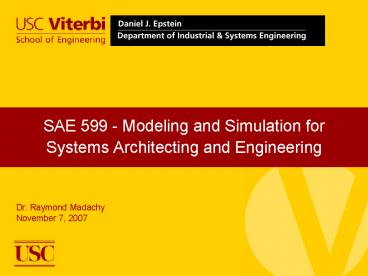SAE 599 Modeling and Simulation for Systems Architecting and Engineering - PowerPoint PPT Presentation
1 / 21
Title:
SAE 599 Modeling and Simulation for Systems Architecting and Engineering
Description:
Review of basic structures and behaviors for continuous systems. Monte Carlo analysis ... Open book, calculator and computer* 6:30 9:10 on November 14 ... – PowerPoint PPT presentation
Number of Views:38
Avg rating:3.0/5.0
Title: SAE 599 Modeling and Simulation for Systems Architecting and Engineering
1
SAE 599 - Modeling and Simulation for Systems
Architecting and Engineering
- Dr. Raymond Madachy
- November 7, 2007
2
Outline
- Review of basic structures and behaviors for
continuous systems - Monte Carlo analysis
- Homework review
- Test preparations
- Project discussions
3
Level Integration
- Calculus integral
- System dynamics code
Level(time) Level(time-dt) (inflow -
outflow)dt
4
Basic Structures
- Rate/level system (no feedback)
- Positive and negative feedback systems
5
Behaviors from Rate/Level Structure
6
Behaviors from Rate/Level Structure (cont.)
7
Behaviors from Feedback Structures
8
Rate and Level Worksheet
Level(time) Level(time-dt) (inflow -
outflow)dt
9
Monte Carlo Analysis
- Monte Carlo is a "game of chance" technique that
applies random sampling from known input
probability distributions to create output
distributions. It estimates the likely range of
outcomes from a complex random process by
simulating the process a large number of times. - The following steps are performed for n
iterations in a Monte Carlo analysis, where an
iteration refers to a single simulation run - For each random variable, take a sample from its
probability distribution function and calculate
its value. - Run a simulation using the random input samples
and compute the corresponding simulation outputs. - Repeat the above steps until n simulation runs
are performed. - Determine the output probability distributions of
selected dependent variables using the n values
from the runs.
10
Inverse Transform Method
- A random number r is chosen that is uniformly
distributed between 0 and 1. It is set equal to
the cumulative distribution, F(x) r, and x is
solved for. A particular value r0 gives a value
x0, which is a particular sample value of X - x0 F-1(r0).
11
Monte Carlo Example Input Sampling
12
Monte Carlo Example Outputs
13
10/31 Homework Problem
14
10/31 Homework Problem (cont.)
15
10/31 Homework Problem (cont.)
16
10/17 Brookss Law Model Homework Review
- Per Systems Architecting principles, ambiguous
and unbounded problems require creative heuristic
thinking, cut and run approaches - Choice of staffing levels, structures and
resource allocation - Allocation between new and experienced separate
flow chains for design and construction vs.
sharing resources in existing personnel chain - Phasing and overlap assumptions
- Unknown project size in lines of code
- Provide rationale for your model architecting
decisions - Due November 21
17
Resource Allocation Example
Squeaky wheel gets the grease
fractional resources to task 1 (task 1
backlog/task 1 productivity) / ((task 1
backlog/task 1 productivity) (task 2
backlog/task 2 productivity)) task 1 work
completion (total resources available
fractional resources to task 1) task 1
productivity
18
Reconciling COCOMO II Phase Distributions and
Dynamic Staffing Profiles
19
Test Logistics
- Open book, calculator and computer
- 630 910 on November 14
- Remote DEN students will not be proctored, but
are required to email or fax their tests to DEN
at the end - open Internet only if 100 of students will
have access
20
Test Topic Coverage
- All lectures and demonstrations
- Readings covered
- Law-Kelton Textbook
- Chapter 1 basic simulation modeling
- Chapter 3 simulation software
- Chapter 4 basic probability and statistics
- Chapter 5 - validation
- Software Process Dynamics
- Chapter 1 (part) introduction to applied system
dynamics modeling - Chapter 2 the modeling process with system
dynamics - Chapter 3 model structures and behaviors
- Appendix A statistics of simulation
21
Test Topic Coverage (cont.)
- Homework problems
- Tool survey
- Discrete event simulations
- Continuous simulation (10/31 problem on hardware
components and defects not 10/17 Brookss Law
model homework) - Be able to simulate by hand
- Discrete event scenarios (e.g. waiting times,
queue lengths) - Continuous systems levels from rate inputs
- Monte Carlo random variate generation































